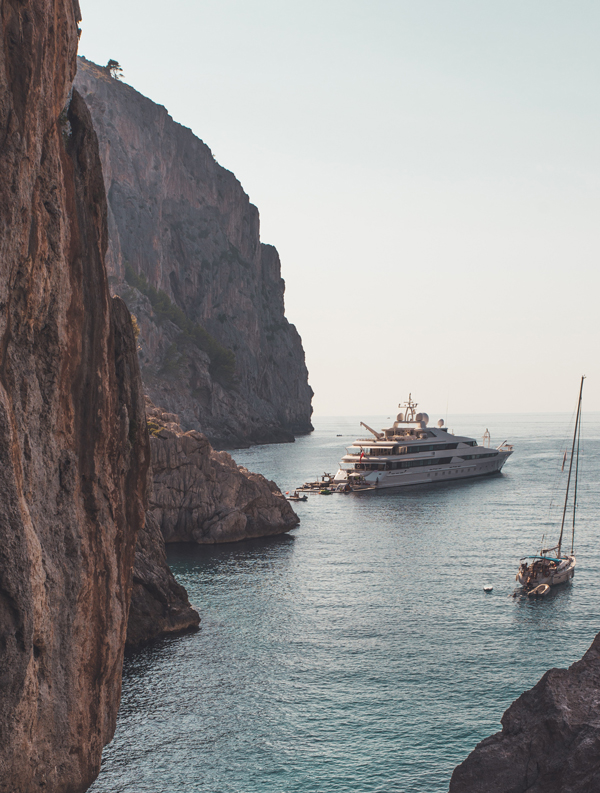
Fancy a Superyacht for Christmas?
17 December 2020
In this my final piece for this epic Covid year of 2020, I take a good look at the SuperYacht industry and what is involved in running one of these big sea beasts. The global SuperYacht industry, with an annual turnover of €25 Billion, now boasts nearly 5,000 of these super vessels over 24 meters in length currently in service globally. In the UK alone, this industry turns over around £700 million per year and employs 5,000 people directly in building, repair, services, crewing and management. In conversation with Alasdair Milroy, MD of the SuperYacht Accountancy & Management Firm, “Breaking the Mould Accounting”, I look at the complexities of running what is a commercially sophisticated operation, I analyze why these vessels have never been as popular as they are today, and then finally decide whether I really want a SuperYacht in my Christmas stocking…
My JLR Agency is already connected with the SuperYacht industry. We have plans to charter a SuperYacht for a VIP music and film event next year in the Mediterranean. Currently on hold and subject to Covid restrictions being lifted, of course. We also have two Guernsey-based partners who work in this space, brokering crew and VAT-free refueling deals, as well as providing accountancy and management services to the SuperYacht owners and their captains. A very big business. However, my attention was drawn to this topic earlier this year by an unusual news story that made the front page in the Spanish newspapers. A story that involved a SuperYacht, a leading Spanish Banker and an original Picasso painting…and ended in a jail sentence and very significant fine.
The individual at the centre of this story was one Jaime Botín, Spanish billionaire banker worth $1.7 billion in 2019 due to his shareholding in the Spanish banking group, Bankinter. Owner of the SuperYacht “Adix”, he was found guilty at the start of this year by the Spanish courts of attempting to smuggle out of the country on his luxury vessel an original Picasso painting known as “Head of a Young Woman”. His sentence resulted in him having to pay €52.4 million ($60.1 million) of his wealth as well as serve 18 months in jail for breaking an earlier court order prohibiting the removal of Picasso’s masterpiece. The painting was also confiscated by the Spanish state – a further €26 million ($28.8 million) removed from his personal estate, which is the estimated value of the artwork. One hell of an expensive boat ride…
This high profile story highlighted three points for me. Firstly, crime doesn’t pay. Secondly, how could anyone be so stupid? Especially someone at his level with such supposed financial experience. More importantly, where was the overseeing specialist advice that would have alerted him to the fact that owning a valuable asset such as a famous painting could have significant implications at many levels, especially if it was kept on a private yacht? Talking with Alisdair Milroy on this subject, he commented as follows: “You would be amazed at how much original artwork is currently sitting on these SuperYachts. Picasso, Leonardo da Vinci, Rodin, Cezanne, Monet, Velazquez. The owners like to look at these objects of beauty while they travel the oceans, but they are not necessarily aware of the consequences and possible issues. A work of art is linked to the jurisdiction of origin and can be seen as an inherent asset of that nation state. To remove it can be considered a criminal act, as happened with Botín. Furthermore, by taking your vessel into certain jurisdictions, even if only to refuel, you may find that the owners of the vessel have accrued a wealth tax or duty related to the current market value of that painting. And then there are the additional issues regarding security and insurance.”
So all that’s just about a single item sitting inside a SuperYacht. What about the vessels themselves? How much do they cost? What do you actually need to run them? What can you do with them? What about the running costs? Is ownership tempting me?
The definition of a SuperYacht is linked to its size. It needs to have a minimum load line length of 24 metres, or approximately 75 ft. The largest known SuperYacht in the world is “Azzam”, measuring an incredible 590 ft long (180 Metres) and built at a cost of $600 Million. Truly staggering. A middle range SuperYacht is likely to set one back a mere $100 Million. The statistics for these vessels are truly breathtaking.
– Annual operating costs: 5 to 10% of purchase price
– Crew and Captain salaries: $150,000 per month (crew of 15)
– Captain salary: $15,000 per month
– Deckhand salary: $3,000 per month
– Luxury SuperYacht charter hire: $150,000 per week
– Fuel: $75,000 per refueling
SuperYachts are recognised as commercially operated vessels, professionally crewed and managed as commercial operations, often owned by asset-holding companies, perhaps within a larger asset-holding structure. For Alasdair, therein lies a major issue for owners and their asset managers: “One of the key issues to consider, which is often ignored or forgotten by the owners, is the actual use/purpose of the vessel – is it for their own pleasure or is it for commercial activity? Or both? The difference could have serious cost, tax and licensing implications. The flag states apply different rules to a commercial yacht than to a privately-used vessel. I could have the exact same 55 metre yacht and if I operate commercially I have to have ISM Safety Management and MLC (Crew Welfare) certificates.
If I operate the same yacht for pleasure then there is no MLC or ISM requirement, although there are the same risks to life of guests and crew. I sense that the authorities will be tightening up on the specific use of these vessels and if the commercial role is not justified there could well be retrospective fees and even fines.”
Here in Guernsey we regularly see the SuperYachts arriving and sometimes staying for several days. Not just to refuel, but also to stock up with kitchen supplies and also allow the crew some shore leave and leisure time. Many of them even come with their own helicopters strapped to the decks. As you do. Of such significance that they regularly feature in the local newspaper – guess who’s just sailed into the island! In the current Covid pandemic we have heard that many owners and their families have simply sat out the lockdown period in the safe confines of their own yacht, enjoying warm Caribbean or Mediterranean climes. One way to do Covid time, à la Philip Green. Without any doubt, it is a rapidly-growing industry, as evidenced by last year’s spectacular boat shows in Ft Lauderdale, Miami, Monaco and Southampton. However, as Alasdair says, it is an industry that needs to develop its management and controls:
“For the industry to flourish and grow it requires the participants to educate owners and transition from a young industry driven by a commission-driven model to one that takes responsibility for training and educating crew, adopting safety and robust financial practices and, most importantly, educating the owners to approach their investment in a yacht and the lifestyle opportunities it provides in the same way they would their business or personal wealth.”
So, will I or my wife be finding a SuperYacht in our Christmas Stockings this year? No. I think not. In fact, I think my chances of walking on Mars are considerably higher than becoming the owner of a SuperYacht. And it’s not just because of the eye-watering numbers involved. Having spoken with many people in the industry, so many tell me of the amount of ongoing work and headaches involved in just maintaining and running these assets. I would need to have unlimited disposable cash at the level of individuals like Pablo Escobar and Carlos Slim. Legal, obviously. Better to be invited onto one and let someone else pick up the bill. But then, one can always aspire and dream…Would be nice.
And if I did find the millions of stash needed, I would ensure that I had in place the proper financial oversight of the yacht, enjoying good regular communication with my Captain. Keeping him/her up-to-date with the financials and legalities so that decisions can be made based on real time data and advice taken in advance, rather than after the event. Only then could I sleep, on my sunny sun deck…
José Luis Romanillos MA TEP
Copyright: J L Romanillos Ltd
With acknowledgment and grateful thanks to Alasdair Milroy, Founder & CEO of Breaking
The Mould, SuperYacht Accountancy & Management Firm based in Guernsey, CI.



Leave A Comment